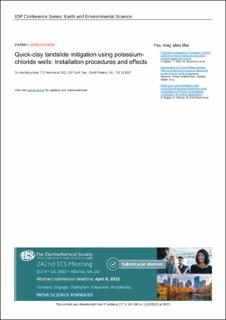Quick-clay landslide mitigation using potassium-chloride wells: Installation procedures and effects
Helle, Tonje Eide; Kvennås, Marianne; Kirkevollen, O. V.; Hamel, B.; Bache, Bjørn Kristian Fiskvik; Strand, S. A.; Svanø, G.; Gylland, A.; Haugen, E.; Wiig, T.; Horn, A.
Peer reviewed, Journal article
Published version
Permanent lenke
https://hdl.handle.net/11250/2994879Utgivelsesdato
2021Metadata
Vis full innførselSamlinger
- NGI articles [1061]
Originalversjon
IOP Conference Series: Earth and Environmental Science (EES). 2021, 710 (012047), . 10.1088/1755-1315/710/1/012047Sammendrag
Mitigation actions related to quick-clay slopes often induce undesirable changes to the terrain that may have negative impact on developed areas and local biodiversity. Soil improvement may prevent this. Lime-cement piling causes temporarily reduced slope stability and substantial climate-gas emissions. Less climate-gas emissions are associated to the production of potassium chloride (KCl). KCl improves the post-failure properties of quick clay so it renders not quick and may serve as an alternative to current landslide-mitigation. The mechanisms in this chemical process is well documented, but there exist no installation procedures for KCl wells, nor knowledge on cost/benefit or climate-gas emissions. This paper presents two installation procedures of KCl wells, and studies showing that the climate-gas emissions are far less than installing lime-cement piles. Further development of cost-effective installation procedures is needed to justify application of KCl wells in quick-clay areas.
